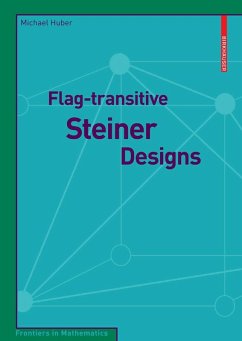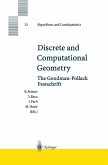The characterization of combinatorial or geometric structures in terms of their groups of automorphisms has attracted considerable interest in the last decades and is now commonly viewed as a natural generalization of Felix Klein's Erlangen program(1872).Inaddition,especiallyfor?nitestructures,importantapplications to practical topics such as design theory, coding theory and cryptography have made the ?eld even more attractive. The subject matter of this research monograph is the study and class- cation of ?ag-transitive Steiner designs, that is, combinatorial t-(v,k,1) designs which admit a group of automorphisms acting transitively on incident point-block pairs. As a consequence of the classi?cation of the ?nite simple groups, it has been possible in recent years to characterize Steiner t-designs, mainly for t=2,adm- ting groups of automorphisms with su?ciently strong symmetry properties. For Steiner 2-designs, arguably the most general results have been the classi?cation of all point 2-transitive Steiner 2-designs in 1985 by W. M. Kantor, and the almost complete determination of all ?ag-transitive Steiner 2-designs announced in 1990 byF.Buekenhout,A.Delandtsheer,J.Doyen,P.B.Kleidman,M.W.Liebeck, and J. Saxl. However, despite the classi?cation of the ?nite simple groups, for Steiner t-designs witht> 2 most of the characterizations of these types have remained long-standing challenging problems. Speci?cally, the determination of all ?- transitive Steiner t-designs with 3? t? 6 has been of particular interest and object of research for more than 40 years.
Dieser Download kann aus rechtlichen Gründen nur mit Rechnungsadresse in A, B, BG, CY, CZ, D, DK, EW, E, FIN, F, GR, HR, H, IRL, I, LT, L, LR, M, NL, PL, P, R, S, SLO, SK ausgeliefert werden.
"This monograph provides an excellent development of the existence and nonexistenc of flag-transitive and other symmetric Steiner t-designs. In particular, it develops complete classification of all flag-transitive Steiner t-designs for strength t at least three.
The topic is a beautiful mixture of algebra and combinatorics, and it impinges o many applications areas. Of particular value is the material providing the necessar background in group theory, incidence geometry, number theory, and combinatoria design theory to support a complete exposition of the many results. These form th focus of the first three chapters. Chapter 4 then develops results on symmetric action of groups on Steiner systems, and provides many helpful examples. Chapter 5 the states the main existence result for flag-transitive Steiner systems, and places this i the context of related existence results for highly symmetric actions. Chapters 6 throug 10 fill in the details of the existence proof. Steiner quadruple systems are treated i Chapter 6, while strength three in general is treated in Chapter 7. Chapters 8 and then treat the cases of strengths four and five, respectively. Finally Chapter 10 provide the proof that no flag-transitive Steiner 6-design exists.
The presentation is lucid and accessible. Indeed the author has done a first rate job o presenting material that involves many deep ideas and a number of technical issues. A the same time, the monograph indicates useful next steps to take in the research topic."
Zentralblatt Math - Charles J. Colbourn (Tempe)
The topic is a beautiful mixture of algebra and combinatorics, and it impinges o many applications areas. Of particular value is the material providing the necessar background in group theory, incidence geometry, number theory, and combinatoria design theory to support a complete exposition of the many results. These form th focus of the first three chapters. Chapter 4 then develops results on symmetric action of groups on Steiner systems, and provides many helpful examples. Chapter 5 the states the main existence result for flag-transitive Steiner systems, and places this i the context of related existence results for highly symmetric actions. Chapters 6 throug 10 fill in the details of the existence proof. Steiner quadruple systems are treated i Chapter 6, while strength three in general is treated in Chapter 7. Chapters 8 and then treat the cases of strengths four and five, respectively. Finally Chapter 10 provide the proof that no flag-transitive Steiner 6-design exists.
The presentation is lucid and accessible. Indeed the author has done a first rate job o presenting material that involves many deep ideas and a number of technical issues. A the same time, the monograph indicates useful next steps to take in the research topic."
Zentralblatt Math - Charles J. Colbourn (Tempe)
This monograph provides an excellent development of the existence and nonexistence of flag-transitive and other symmetric Steiner t-designs. In particular, it develops a complete classification of all flag-transitive Steiner t-designs for strength t at least three. The topic is a beautiful mixture of algebra and combinatorics, and it impinges on many applications areas. Of particular value is the material providing the necessary background in group theory, incidence geometry, number theory, and combinatorial design theory to support a complete exposition of the many results. These form the focus of the first three chapters. Chapter 4 then develops results on symmetric actions of groups on Steiner systems, and provides many helpful examples. Chapter 5 then states the main existence result for flag-transitive Steiner systems, and places this in the context of related existence results for highly symmetric actions. Chapters 6 through 10 fill in the details of the existence proof. Steiner quadruple systems are treated in Chapter 6, while strength three in general is treated in Chapter 7. Chapters 8 and 9 then treat the cases of strengths four and five, respectively. Finally Chapter 10 provides the proof that no flag-transitive Steiner 6-design exists. The presentation is lucid and accessible. Indeed the author has done a first rate job of presenting material that involves many deep ideas and a number of technical issues. At the same time, the monograph indicates useful next steps to take in the research topic. Zentralblatt Math - Charles J. Colbourn (Tempe)









